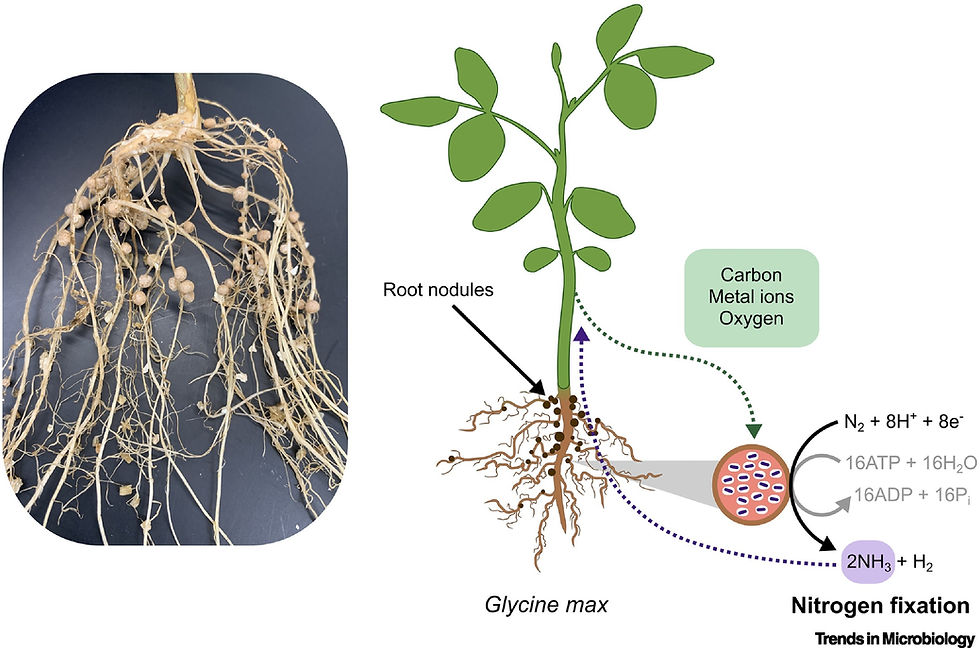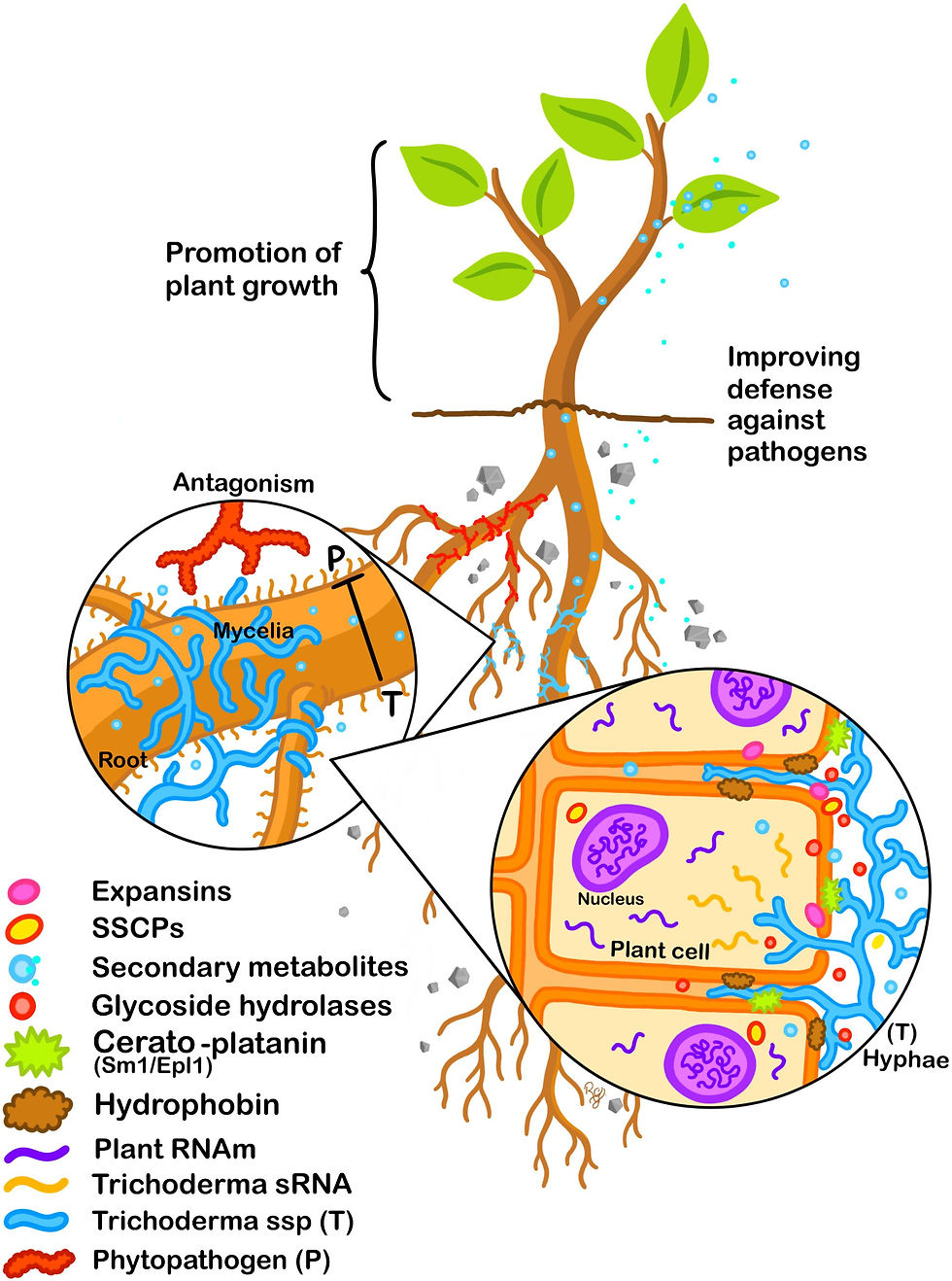Bradyrhizobium japonicum in Soybean cultivation, supporting Nitrogen Fixation in Northern Climates
- Stanislav M.

- Sep 26
- 8 min read
Bradyrhizobium japonicum stands as one of agriculture's most sophisticated microbial partners, specifically evolved to form symbiotic relationships with soybean plants where it converts atmospheric nitrogen into bioavailable forms through advanced enzymatic processes. This nitrogen-fixing bacterium has become increasingly critical for sustainable soybean production, particularly in northern regions like Ontario, Canada, where cool soil temperatures and shorter growing seasons present unique challenges that require specialized microbial solutions.
In an era where sustainable agriculture practices are paramount and synthetic fertilizer costs continue rising, B. japonicum offers a biological pathway to enhance soybean productivity while reducing environmental impact. This comprehensive analysis explores the intricate mechanisms of B. japonicum symbiosis, its remarkable adaptations to cooler climates, and practical applications for maximizing soybean yields in northern growing regions.
The Sophisticated Nitrogen Fixation Mechanism of Bradyrhizobium japonicum
Bradyrhizobium-Soybean Symbiosis: Unlike other rhizobia that nodulate various legume species, B. japonicum has evolved an exclusive partnership with soybean (Glycine max), creating one of nature's most efficient nitrogen-fixing systems. This highly specialized relationship begins when soybean roots release specific flavonoid compounds—primarily genistein and daidzein—into the rhizosphere under nitrogen-limiting conditions. These molecular signals act as chemical attractants that B. japonicum recognizes with remarkable precision.

The bacteria respond by synthesizing specialized Nod factors (lipochitooligosaccharides) that are uniquely structured to interact with soybean root receptors. This molecular handshake initiates a complex infection process where root hairs curl around bacterial cells, forming infection threads that guide the bacteria into cortical root cells. The result is the formation of specialized root nodules—new plant organs where B. japonicum differentiates into bacteroids capable of intensive nitrogen fixation.
Advanced Enzymatic Nitrogen Conversion: Within mature nodules, B. japonicum expresses the nitrogenase enzyme complex, a sophisticated two-component system consisting of dinitrogenase and dinitrogenase reductase encoded by bacterial nif genes. This enzymatic machinery represents one of biology's most energy-intensive processes, requiring approximately 16 ATP molecules and multiple electrons per molecule of atmospheric nitrogen (N₂) converted to ammonia (NH₃).

The nitrogenase complex features a unique molybdenum-iron cofactor at its active site, which serves as the catalytic center for breaking nitrogen's exceptionally stable triple bond. The plant host supplies the bacteroids with energy-rich compounds like malate and succinate, which fuel this demanding process through cellular respiration pathways specifically adapted for the low-oxygen nodule environment.
Oxygen Management and Leghemoglobin: A critical aspect of B. japonicum's nitrogen fixation is the precise regulation of oxygen within nodules. The nitrogenase enzyme is irreversibly inactivated by oxygen, yet the bacteroids require oxygen for cellular respiration to generate ATP.
Soybean plants solve this paradox by producing leghemoglobin, an oxygen-binding protein that maintains the microaerobic conditions necessary for both nitrogenase function and bacterial respiration. Active nodules exhibit a characteristic pink-red color due to leghemoglobin, serving as a visual indicator of effective nitrogen fixation.
The result of this sophisticated symbiosis is that well-nodulated soybeans can derive 80-100% of their nitrogen requirements from biological fixation, typically contributing 100-200 kg N/ha per season under optimal conditions. This biological nitrogen source eliminates the need for synthetic fertilizers while providing a consistent nutrient supply throughout the growing season.

Enhanced Performance in Northern Climates: Cold Tolerance and Adaptation
Temperature Challenges in Northern Regions: Soybean production in northern climates like Ontario faces significant challenges related to cool soil temperatures during the critical nodulation period. The optimal temperature range for B. japonicum growth and nodulation is 25-30°C, but northern regions often experience soil temperatures of 15-20°C during early to mid-growing season. Each degree below 17°C can delay nitrogen fixation onset by approximately 2.5 to 7.5 days, potentially impacting yield potential in short-season environments.
Strain Selection for Cold Tolerance:
Research conducted specifically in Ontario has identified superior cold-tolerant strains that maintain effectiveness under suboptimal temperatures. Notably, B. japonicum strain 532C (also known as 61A152) has demonstrated consistently superior performance across Ontario field conditions, supporting yields of 3.08 t/ha compared to 2.70 t/ha for other commercial strains. This strain's success stems from its ability to maintain active nodulation and nitrogen fixation at lower soil temperatures common in Canadian growing conditions.
Advanced screening programs have identified additional cold-tolerant strains, which demonstrate enhanced growth at 15°C and improved nodulation efficiency under cool soil conditions. These strains exhibit superior competitive infection behaviors at low temperatures, enabling them to establish nodules even when indigenous soil bacteria are present.
Molecular Adaptations to Cold Stress: Cold-tolerant B. japonicum strains possess unique molecular mechanisms that enable function at suboptimal temperatures. Research has shown that these strains maintain Nod factor production at lower temperatures, ensuring successful root hair infection even when soil warming is delayed. Additionally, cold-adapted strains exhibit enhanced expression of cold-shock proteins and modified membrane composition that preserves cellular integrity and metabolic function under thermal stress.
Practical Implications for Ontario Producers: For Ontario soybean growers, utilizing cold-tolerant B. japonicum strains can significantly impact productivity. Field trials demonstrate that appropriate strain selection can increase nodulation rates by 65% and yields by 24% compared to standard strains under typical Ontario spring conditions. This becomes particularly important in no-till systems where soil warming occurs more gradually, and in northern regions where the growing season window is constrained.
Superior Plant Growth Promotion and Yield Enhancement
Comprehensive Growth Enhancement: Beyond nitrogen fixation, B. japonicum provides multiple plant growth-promoting effects that enhance soybean development and yield. Effective inoculation typically increases soybean yields by 30-60% in soils lacking indigenous rhizobia, with benefits extending beyond simple nitrogen provision. The bacteria produce various phytohormones, including indole acetic acid (IAA), which promotes root development and enhances nutrient uptake capacity
Enhanced Root Architecture and Nutrient Uptake: Soybeans inoculated with effective B. japonicum strains develop more extensive root systems with increased surface area for nutrient and water absorption. This enhanced root architecture proves particularly valuable in northern climates where growing seasons are shorter and efficient resource capture is critical. Studies show that inoculated plants exhibit improved root volume and length, contributing to better drought tolerance and nutrient acquisition.
Protein Quality and Nutritional Enhancement: Nitrogen supplied through biological fixation contributes to higher protein content in soybean seeds, often increasing protein levels by 2-4 percentage points compared to mineral nitrogen sources. This enhanced protein quality results from the steady, plant-controlled nitrogen supply that biological fixation provides, contrasting with the variable availability of synthetic fertilizers.
Metabolic Optimization: Recent metabolomic studies reveal that B. japonicum inoculation triggers comprehensive changes in soybean metabolism, including enhanced production of flavonoids, amino acids, and stress-protective compounds. These metabolic adjustments contribute to improved plant resilience, disease resistance, and overall performance under challenging growing conditions typical of northern regions.
Stress Tolerance and Environmental Resilience
Enhanced Drought and Temperature Tolerance: B. japonicum symbiosis significantly improves soybean tolerance to environmental stresses common in northern growing regions. The bacteria produce osmolytes and stress-protective compounds that help plants maintain cellular function under water deficit conditions. Additionally, the enhanced root development promoted by effective symbiosis enables better water extraction from soil profiles.
Disease Resistance and Plant Health: Inoculation with B. japonicum triggers induced systemic resistance mechanisms that enhance soybean defense against soil-borne pathogens. Research demonstrates that nodulated plants show increased activity of defense enzymes, including catalase, peroxidase, and superoxide dismutase, contributing to reduced disease incidence. This biological protection proves particularly valuable in northern regions where cool, wet conditions can favor pathogen development. (source)
Soil Health Enhancement and Microbiome Benefits
Soil Biology Improvement: B. japonicum contributes significantly to soil microbiome health through multiple pathways. As a beneficial soil organism, it enhances microbial diversity and promotes the development of other plant growth-promoting bacteria in the rhizosphere. The increased organic matter return from vigorous soybean growth feeds soil organisms and improves soil structure over time.
Nutrient Cycling Enhancement: The symbiotic relationship enhances cycling of multiple nutrients beyond nitrogen. B. japonicum can solubilize phosphorus and mobilize micronutrients, making them more available to plants. The bacteria also produce organic acids that improve soil structure and promote formation of stable soil aggregates.
Carbon Sequestration: Well-nodulated soybean systems contribute to soil carbon storage through increased root biomass, nodule turnover, and crop residue production. This carbon input feeds soil microbial communities and contributes to long-term soil fertility improvements. In northern climates where soil organic matter building is challenging, this biological carbon input proves particularly valuable.
Suppression of Soil Pathogens: B. japonicum can suppress certain soil-borne pathogens through competitive exclusion and antibiotic production. Research shows that effective rhizobial populations can reduce the incidence of root rot diseases and other soil-borne problems, contributing to healthier soil ecosystems.
Practical Applications for Northern Soybean Production
Inoculation Best Practices: Proper inoculation technique becomes critical in northern climates where environmental conditions may stress bacterial survival. High-quality liquid inoculants often perform better than peat-based formulations in cool conditions, providing better bacterial survival and establishment. Application rates should be increased in first-time soybean fields or following extended rotations away from soybeans.
Soil Management Considerations: Successful B. japonicum establishment requires attention to soil conditions. Soil pH should be maintained above 6.0 for optimal bacterial survival and activity. In acidic soils common in some northern regions, lime application prior to soybean planting can significantly improve nodulation success. Adequate phosphorus and molybdenum availability also supports effective nitrogen fixation.
Field Monitoring and Assessment: Northern producers should monitor nodulation success through regular root examination during early to mid-season. Effective nodules should be pink to red inside, indicating active leghemoglobin and nitrogen fixation. Poor nodulation (white or green nodules, or few nodules) suggests the need for improved inoculation or soil management in subsequent seasons.
Economic and Environmental Benefits
Cost-Effective Nitrogen Supply: B. japonicum inoculation provides exceptional return on investment for soybean producers. With inoculant costs typically ranging from $15-30 per hectare and nitrogen fertilizer exceeding $1.50 per kg of actual N, biological nitrogen fixation offers substantial economic advantages. Effective symbiosis can replace 150-200 kg N/ha of synthetic fertilizer, representing cost savings of $225-300 per hectare.
Reduced Environmental Impact: Biological nitrogen fixation eliminates the greenhouse gas emissions associated with synthetic nitrogen fertilizer production and application. Manufacturing nitrogen fertilizer is energy-intensive, contributing approximately 1-2% of global greenhouse gas emissions. Additionally, biological fixation avoids nitrous oxide emissions that commonly result from synthetic fertilizer application.
Supply Chain Resilience: Developing effective B. japonicum populations in soil reduces dependence on synthetic fertilizers, providing supply chain security during periods of fertilizer shortage or price volatility. This biological nitrogen source remains available regardless of external supply disruptions, contributing to farm resilience and food security.
Future Perspectives and Innovations
Strain Development and Genetic Enhancement: Ongoing research focuses on developing next-generation B. japonicum strains with enhanced cold tolerance, competitive ability, and nitrogen-fixing efficiency. Advanced molecular techniques enable targeted improvements in bacterial performance while maintaining ecological compatibility.
Precision Inoculation Technologies: Emerging technologies enable site-specific inoculation based on soil conditions, previous cropping history, and environmental factors. GPS-guided application systems can vary inoculation rates and formulations across fields, optimizing bacterial establishment and performance.
Integrated Management Systems: Future soybean production systems will likely integrate B. japonicum with other beneficial microorganisms, creating synergistic microbial consortia that provide comprehensive plant nutrition and protection. These systems promise enhanced performance in challenging northern growing conditions.
Climate Adaptation Strategies: As northern regions experience changing climate patterns, B. japonicum research continues developing strains adapted to variable temperature regimes and extreme weather events. These climate-resilient bacteria will be essential for maintaining soybean productivity under future environmental conditions.
Bradyrhizobium japonicum represents a sophisticated biological solution for sustainable soybean production in northern climates. Through advanced nitrogen fixation mechanisms, enhanced stress tolerance, and comprehensive plant growth promotion, this remarkable bacterium enables soybeans to thrive in challenging environmental conditions while reducing dependence on synthetic inputs. For producers in regions like Ontario, utilizing appropriate B. japonicum strains provides both immediate economic benefits and long-term sustainability advantages, positioning soybean production for continued success in an evolving agricultural landscape.
sources:
https://www.sciencedirect.com/science/article/pii/S0944501304700579
https://www.topcropmanager.com/cold-temperatures-hamper-soybean-nodulation-16026/
https://www.sciencedirect.com/science/article/pii/0098847295000177
https://www.sciencedirect.com/science/article/abs/pii/S1161030102000382
https://www.frontiersin.org/journals/microbiology/articles/10.3389/fmicb.2022.846359/full
https://www.indogulfbioag.com/post/rhizobium-species-plant-nutrition
https://manitobapulse.ca/wp-content/uploads/Soybean_Oresnik_rhizobium_year-1-report.pdf
https://acsess.onlinelibrary.wiley.com/doi/abs/10.2134/agronj2002.8700
https://www.sciencedirect.com/science/article/pii/0038071794903042
https://www.sciencedirect.com/science/article/abs/pii/003807178890106X
https://www.sciencedirect.com/science/article/abs/pii/S0929139312000960
https://www.frontiersin.org/journals/plant-science/articles/10.3389/fpls.2022.968496/full
https://www.eco-pb.org/fileadmin/eco-pb/documents/discussion_paper/Zimmer_et_al.__2016_Soja.pdf
https://acsess.onlinelibrary.wiley.com/doi/abs/10.2134/agronj1992.00021962008400060027x
https://www.cropscience.bayer.us/articles/bayer/benefits-of-soybean-nodulation
https://www.sciencedirect.com/science/article/abs/pii/S0038071710003536
https://acsess.onlinelibrary.wiley.com/doi/pdf/10.2134/agronj1992.00021962008400060027x
https://www.sciencedirect.com/science/article/abs/pii/S0065291119300293
https://www.frontiersin.org/journals/plant-science/articles/10.3389/fpls.2021.638452/full
https://enviromicro-journals.onlinelibrary.wiley.com/doi/full/10.1111/1751-7915.13517
https://www.biorxiv.org/content/10.1101/2024.05.27.596129v1.full.pdf
https://www.itheoc.uni-stuttgart.de/.content/mitarbeiter_v3/Dateien/diss_jk.pdf
https://www.sciencedirect.com/science/article/abs/pii/S1161030124000340
https://www.sciencedirect.com/science/article/abs/pii/S1673852724001553
https://www.sciencedirect.com/science/article/pii/S0038071725000616
https://www.sciencedirect.com/science/article/pii/S0944501313001705
https://www.sciencedirect.com/science/article/pii/S2096242820300051
https://www.biorxiv.org/content/10.1101/2025.04.02.646848v1.full-text
https://www.sciencedirect.com/science/article/abs/pii/S0048969717336112
https://microbescipublisher.com/index.php/mmr/article/viewFile/3898/2980



Comments